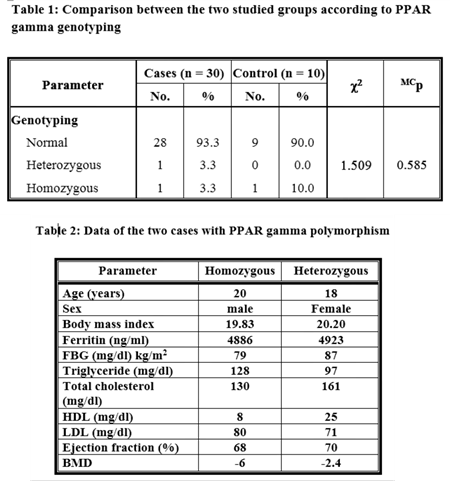A PRELIMINARY STUDY OF THE CARDIAC EFFECT OF PPAR GAMMA IN BETA THALASSEMIA MAJOR WITH IRON OVERLOAD
(Abstract release date: 05/18/17)
EHA Library. El-defrawy M. 05/18/17; 182905; PB2192

Prof. Dr. Mohamed El-defrawy
Contributions
Contributions
Abstract
Abstract: PB2192
Type: Publication Only
Background
Peroxisome proliferator–activated receptor (PPAR)-gamma is a transcription factor belonging to the same family of nuclear receptors as steroid and thyroid hormone receptors. PPAR-gamma is a master transcriptional regulator involved in the expression of probably hundreds of genes. One of PPAR gamma gene polymorphisms is Pro12Ala which is present in at least 80% of humans. Pro12Ala polymorphism may reduce the risk of cardiovascular complications. Consistently, Ala12 allele carriers were found to have lower carotid intima- media thickness and reduced risk of myocardial infarction in type 2 diabetes patients. Pharmacological agonists of PPAR-gamma leads to a molecular switch providing alleviating myocardial injury through modulating oxidative, inflammatory and apoptotic signaling pathway.
Aims
Our aim was to investigate the frequency of Pro12Ala polymorphism (substitution of proline to alanine at codon 12 in exon B of PPARγ gene in Egyptian β-thalassemia major (β-TM) with iron overload. Untreated transfusion induced iron overload in thalassemia major is fatal, usually as a result of cardiac complications.
Methods
30 β-TM patients and 10 healthy volunteer matched for age, sex and body weight were involved in this study. β-TM patients followed up was in the “outpatient clinic of Hematology unit, at Alexandria main university hospital”. Seventeen were males and thirteen were females with ages ranging from 16 – 39 years (21.53±5.44). Blood samples from β-TM patients and healthy controls were analyzed for PPARγ gene polymorphism using polymerase chain reaction-restriction fragment length polymorphism.
Results
The mean value of serum ferritin in β-TM was 4976.30 ± 2216.41 ng/L which was significantly higher than that in controls (102.60 ± 12.69 ng/L). The mean value of ejection fraction were 62.23 ± 3.46% and 63.80 ± 4.34 in cases and controls respectively. Pro12Ala polymorphism was present in 2 out of 30 (6.67%) β-TM patients with osteoporosis. One patient had heterozygous 12Ala polymorphism and the other had homozygous 12Ala polymorphism. Both had normal body mass index, lipid profile, ejection fraction and elevated serum ferritin (4923 ng/l in heterozygous patient and 4886 ng/l in homozygous patient). Ejection fraction was 70% in heterozygous patient and 68% in homozygous patient. Only one male control (10%) has homozygous 12Ala polymorphism.

Conclusion
This study suggests that Pro12Ala polymorphism may have a cardioprotective effect in Egyptian thalassemic patients since we find the highest value of ejection fraction among the two positive cases. Further studies on a larger population of patients are still needed to confirm this finding.
Session topic: 26. Thalassemias
Keyword(s): iron overload, Beta thalassemia
Abstract: PB2192
Type: Publication Only
Background
Peroxisome proliferator–activated receptor (PPAR)-gamma is a transcription factor belonging to the same family of nuclear receptors as steroid and thyroid hormone receptors. PPAR-gamma is a master transcriptional regulator involved in the expression of probably hundreds of genes. One of PPAR gamma gene polymorphisms is Pro12Ala which is present in at least 80% of humans. Pro12Ala polymorphism may reduce the risk of cardiovascular complications. Consistently, Ala12 allele carriers were found to have lower carotid intima- media thickness and reduced risk of myocardial infarction in type 2 diabetes patients. Pharmacological agonists of PPAR-gamma leads to a molecular switch providing alleviating myocardial injury through modulating oxidative, inflammatory and apoptotic signaling pathway.
Aims
Our aim was to investigate the frequency of Pro12Ala polymorphism (substitution of proline to alanine at codon 12 in exon B of PPARγ gene in Egyptian β-thalassemia major (β-TM) with iron overload. Untreated transfusion induced iron overload in thalassemia major is fatal, usually as a result of cardiac complications.
Methods
30 β-TM patients and 10 healthy volunteer matched for age, sex and body weight were involved in this study. β-TM patients followed up was in the “outpatient clinic of Hematology unit, at Alexandria main university hospital”. Seventeen were males and thirteen were females with ages ranging from 16 – 39 years (21.53±5.44). Blood samples from β-TM patients and healthy controls were analyzed for PPARγ gene polymorphism using polymerase chain reaction-restriction fragment length polymorphism.
Results
The mean value of serum ferritin in β-TM was 4976.30 ± 2216.41 ng/L which was significantly higher than that in controls (102.60 ± 12.69 ng/L). The mean value of ejection fraction were 62.23 ± 3.46% and 63.80 ± 4.34 in cases and controls respectively. Pro12Ala polymorphism was present in 2 out of 30 (6.67%) β-TM patients with osteoporosis. One patient had heterozygous 12Ala polymorphism and the other had homozygous 12Ala polymorphism. Both had normal body mass index, lipid profile, ejection fraction and elevated serum ferritin (4923 ng/l in heterozygous patient and 4886 ng/l in homozygous patient). Ejection fraction was 70% in heterozygous patient and 68% in homozygous patient. Only one male control (10%) has homozygous 12Ala polymorphism.

Conclusion
This study suggests that Pro12Ala polymorphism may have a cardioprotective effect in Egyptian thalassemic patients since we find the highest value of ejection fraction among the two positive cases. Further studies on a larger population of patients are still needed to confirm this finding.
Session topic: 26. Thalassemias
Keyword(s): iron overload, Beta thalassemia
{{ help_message }}
{{filter}}


